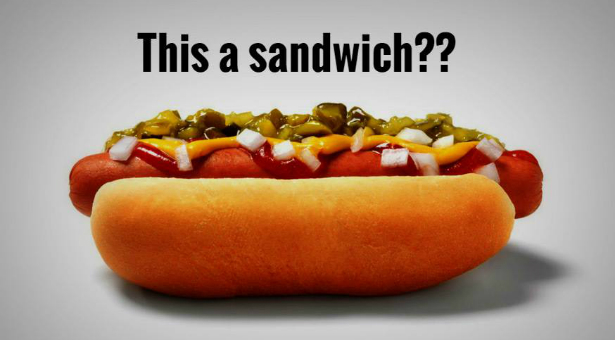Dismantling the Hotdog-as-Sandwich Argument
January 7, 2020
Imagine: You are seated at the Whippany Diner. You’re hungry for a sandwich, but feeling audacious. So, when the waiter takes your order, you ask for their best sandwich. The waiter approaches with a silver cloche serving dish (as is customary at the Diner), and your mouth waters as you imagine the Italian sub or Taylor ham, egg, and cheese or turkey club underneath. But when the cloche is lifted, you find yourself faced with a hotdog. The waiter asks if you would like ketchup, but you are so immediately confused that you fail to hear. You’re disappointed not because hotdogs are bad, but because you expected a sandwich.
I pose this hypothetical situation to convey this: The claim that a hotdog is a sandwich is offensive and runs counter to our conventional definition of a sandwich, which we, as a civilized society, adhere to. I will prove my position by employing a physical and philosophical argument.
Proponents of the hotdog-as-sandwich argument rely on the oversimplified definition of a sandwich as ingredients between bread. Our conventional definition of a sandwich, however, is much more complex. I will explain. As you read (or if you’re foolish enough to think a hotdog a sandwich, are read to), visualize a traditional sandwich — e.g. ham and swiss on rye or peanut butter and jelly on white bread — on a countertop. Next, visualize the transverse, or horizontal plane, which would be parallel to the countertop. Notice that in the traditional sandwich that you imagined, the space between the two flat pieces of bread that contains the ingredients is also oriented parallel to the horizontal plane. Now, visualize a hotdog. Notice that unlike a sandwich, the slit in which the hotdog lies is oriented perpendicular to the horizontal plane; the ingredients face upward. Herein lies the first point of difference between a hotdog and a sandwich.
The secondary reason why hotdogs and sandwiches should be separately categorized lies in the essence of the food-in-question, and its dependency on bread. For example, if you strip a sandwich of the material that confines its ingredients, you no longer have a sandwich. If the bread is removed from a ham sandwich, you are left with an unstructured pile of cold cuts. However, if you remove the bun from a hotdog, it remains a hotdog, maintaining its essence. This difference in composition and the previously mentioned difference in orientation are what separates hotdog from sandwich.
Certain questions arise from my argument: If a hotdog is not a sandwich, what is it? Is a hotdog an open-faced sandwich? To the latter question, an open-faced sandwich is a chaotic, illogical, structureless gray area that I refuse to entertain now. As for the former, perhaps hotdogs are of their own category. Nonetheless, I assert that we all, unconsciously or consciously, subscribe to the aforementioned conventional sandwich definition, which is why any reasonable person would be offended by the scenario that I posed at the start of this piece. Barbaric and smugly contrarian adherents to the hotdog-as-sandwich argument fight this natural and just definition, and I invite anyone possessing the opposite opinion to voice such unsound logic. As for my fellow hotdog-as-hotdog advocates: We have the logical and moral high ground and should relish in that fact.
